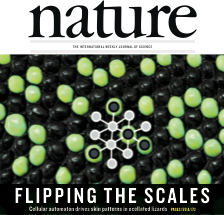From the clown fish to leopards, skin colour patterns in animals arise from microscopic interactions among coloured cells that obey equations discovered by the mathematician Alan Turing. Today, we report in the journal NATURE that a southwestern European lizard slowly acquires its intricate adult skin colour by changing the colour of individual skin scales using an esoteric computational system invented in 1948 by another mathematician: John von Neumann. We show that the 3D geometry of the lizard’s skin scales causes the Turing mechanism to transform into the von Neumann computing system, allowing biology-driven research to link, for the first time, the work of these two mathematical giants.
 --> read the original article HERE
--> read the original article HERE
A multidisciplinary team of biologists, physicists and computer scientists lead by Michel Milinkovitch, professor at the Department of Genetics and Evolution of the University of Geneva (UNIGE) Faculty of Science, Switzerland and Group Leader at the SIB Swiss Institute of Bioinformatics, realised that the brown juvenile ocellated lizard (Timon lepidus) gradually transforms its skin colour as it ages to reach an intricate adult labyrinthine pattern where each scale is either green or black. This observation is at odd with the mechanism, discovered in 1952 by the mathematician Alan Turing, that involves microscopic interactions among coloured cells. To understand why the pattern is forming at the level of scales, rather than at the level of biological cells, two PhD students, Liana Manukyan and Sophie Montandon, followed individual lizards during 4 years of their development from hatchlings crawling out of the egg to fully mature animals. For multiple time points, they reconstructed the geometry and colour of the network of scales by using a very high resolution robotic system developed previously in the Milinkovitch laboratory.
Flipping from green to black
We were then surprised to see the brown juvenile scales change to green or black, then continue flipping colour (between green and black) during the life of the animal. This very strange observation prompted Milinkovitch to suggest that the skin scale network forms a so-called ‘cellular automaton’ (check also Wolfram MathWorld). This esoteric computing system was invented in 1948 by the mathematician John von Neumann (together with Stanislaw Ulam). Cellular automata are lattices of elements in which each element changes its state (here, its colour, green or black) depending on the states of neighbouring elements. The elements are called cells but are not meant to represent biological cells; in the case of the lizards, they correspond to individual scales.
These abstract automata were extensively used to model natural phenomena, but we discovered what seems to be the first case of a genuine 2D automaton appearing in a living organism. Analyses of the four years of colour change allowed us to confirm our initial hypothesis: the scales were indeed flipping colour depending of the colours of their neighbour scales. Computer simulations implementing the discovered mathematical rule generated colour patterns that could not be distinguished from the patterns of real lizards.
How could the interactions among pigment cells, described by Turing equations, generate a von Neumann automaton exactly superposed to the skin scales? The skin of a lizard is not flat: it is very thin between scales and much thicker at the center of them. Given that Turing’s mechanism involves movements of cells, or the diffusion of signals produced by cells, Milinkovitch understood that this variation of skin thickness could impact on the Turing’s mechanism. The researchers then performed computer simulations including skin thickness and saw a cellular automaton behaviour emerge, demonstrating that a Cellular Automaton as a computational system is not just an abstract concept developed by John von Neumann, but also corresponds to a natural process generated by biological evolution.
The need for a formal mathematical analysis
However, the automaton behaviour was imperfect as the mathematics behind Turing’s mechanism and von Neumann automaton are very different. Milinkovitch called in the mathematician Stanislav Smirnov, also Professor at the UNIGE, who was awarded the Fields Medal in 2010. Smirnov then derived a so-called discretisation of Turing’s equations that would constitute a formal link with von Neumann’s automaton. Anamarija Fofonjka, a third PhD student in Milinkovitch’s team implemented these new equations in computer simulations, obtaining a system that had become un-differentiable from a von Neumann automaton.
Read the article in NATURE